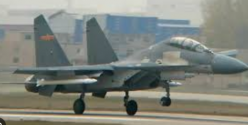How far can a SM6 without booster even go?Chinese long range SAMs that can fit on existing fighter fleet is HQ-16. Which is 5m in length iirc and the longest ranged one is around 70km claimed. Let's suppose it is 100km due to HQ-16 range being understated especially considering its size and suppose you can even double that range when firing high altitude and high speed, that's barely better than a PL-15. (Which is partly why I'm convinced the latest HQ-16 variant far exceeds the claimed 70km range).
HQ-22 might be a better missile to convert but that's about 3x the volume of PL-15 and definitely not over 600km in range when fired in that airborne position.
The SM-6 is a good missile. It's one of the US best SAMs. For its size and range, it must be using the best energetics available. Contrast to HQ-16C with a claimed 70km despite being almost as massive as a SM-6 with booster. That's less than half the range (as claimed).
I think the US went with a cost saver route with this conversion. Albeit it must be said that this is a good missile to convert. China has had the funds to develop optimised AAMs from the ground up as opposed to retrofitting a SAM onto a fighter. ALBMs though... well that's a different user case lol.
The "normal" target range for HQ16 is 160km.
I think SAMs from China in general have more artificially "capped" ranges, because the missiles are supposed to have a heavy focus on anti-EW and anti-jamming. HQ9/19 is massive sized relative to its range, but we know that they're also amazing at hitting any targets at any altitude.
You can see that because some of the AAMs are much slimmer and still have way better ranges. I would guess that a HQ16 can go further than 160km, but it wouldn't fulfil the level of tracking (esp counter terminal phase BM) that the manufacturer expects from it.
I think US getting a reliable 200-300km AAM, even if it probably has a lot of drawbacks to launch without booster that they're not saying, is a gamechanger for the USAF. But only because AIM120 is so bad.
Like if USN got brahmos instead of harpoon, it would be a gamechanger, not because brahmos is wunderwaffen, but because harpoon is outdated trash.


